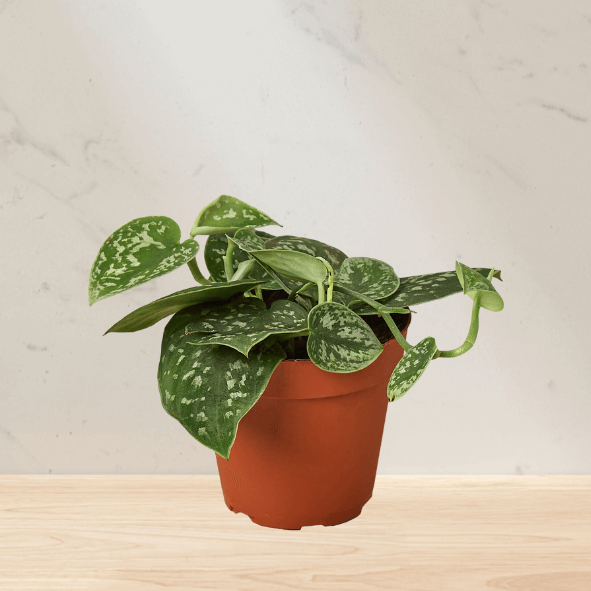 Image 1 of 2
Image 1 of 2

 Image 2 of 2
Image 2 of 2



Pink Princess Philodendron
Introducing the Pink Princess Philodendron, a rare and coveted addition to any plant collection! This beautiful plant is a type of climbing vine with heart-shaped leaves that are a vibrant shade of pink. The leaves of the Pink Princess Philodendron are a standout feature, and are sure to add a pop of color to any room.
This particular Pink Princess Philodendron is potted in a 4 inch pot, making it the perfect size for a windowsill or tabletop display. With proper care, this plant can grow long, trailing vines that will add a touch of whimsy to your space.
Introducing the Pink Princess Philodendron, a rare and coveted addition to any plant collection! This beautiful plant is a type of climbing vine with heart-shaped leaves that are a vibrant shade of pink. The leaves of the Pink Princess Philodendron are a standout feature, and are sure to add a pop of color to any room.
This particular Pink Princess Philodendron is potted in a 4 inch pot, making it the perfect size for a windowsill or tabletop display. With proper care, this plant can grow long, trailing vines that will add a touch of whimsy to your space.
Introducing the Pink Princess Philodendron, a rare and coveted addition to any plant collection! This beautiful plant is a type of climbing vine with heart-shaped leaves that are a vibrant shade of pink. The leaves of the Pink Princess Philodendron are a standout feature, and are sure to add a pop of color to any room.
This particular Pink Princess Philodendron is potted in a 4 inch pot, making it the perfect size for a windowsill or tabletop display. With proper care, this plant can grow long, trailing vines that will add a touch of whimsy to your space.
Houseplant Characteristics
Comes in a 4 in nursery pot (comes in the pot pictured)
Grown in the United States
Trailing Vine Plant
Great Houseplant For Indoors
Low Light Needs
Toxic to Cats & Dogs
Basic Care Instructions
Sunlight
The Pink Princess Philodendron thrives in indirect, medium to low light. It is not tolerant of direct sunlight, which can scorch the leaves and cause the plant to become stressed. It is best to place the plant in a location with bright, indirect light, such as near a north- or east-facing window. This will ensure that the plant receives enough light to grow, without being subjected to too much direct sun.
Watering
The Pink Princess Philodendron should be watered regularly, allowing the soil to dry out slightly between waterings. Overwatering can lead to root rot, so it is important to make sure the soil has good drainage and to avoid letting the plant sit in standing water. A good rule of thumb is to water the plant when the top inch or so of soil feels dry to the touch. It is also a good idea to use a moisture meter to help gauge the moisture level of the soil.
Temperature & Humidity
The Pink Princess Philodendron prefers a consistent room temperature between 60-75°F (15-24°C). It is sensitive to extreme temperatures and should be protected from drafts and heat sources. As for humidity, the Pink Princess Philodendron prefers a moderate level of humidity. Placing the plant in a room with a humidifier or grouping it with other plants can help to increase the humidity around it.
Soil Requirements
The Pink Princess Philodendron prefers a soil mixture that is well-draining and has a neutral pH level. A good combination would be equal parts potting soil, perlite, and peat moss. It is important to use a soil that has a neutral pH level to avoid causing stress to the plant, and to fertilize the plant occasionally with a balanced, all-purpose plant food to provide it with necessary nutrients.
Frequently Asked Questions
-
The pink princess philodendron, also known as the philodendron erubescens, is not a particularly rare variety of philodendron. It is a hybrid plant that was created by crossing the red-leaved philodendron with the green-leaved philodendron, and it is known for its pink and green variegated leaves. However, it is a relatively new cultivar and may be harder to find in some areas compared to more common philodendron varieties.
-
To propagate your pink princess philodendron, you can use stem cuttings. To do this, use a sharp, clean knife or scissors to cut a stem with at least two or three leaves on it from the parent plant. Remove the lower leaves and dip the cut end in rooting hormone, then plant it in moist soil or a rooting medium. Water the soil and place the cutting in a warm, well-lit location, making sure to keep the soil moist but not soggy. It can take several weeks to a few months for the cutting to root and develop new growth.
-
The pink princess philodendron has become popular in recent years due to its attractive, variegated pink and green leaves. It is also a relatively easy plant to care for, making it a popular choice for both experienced plant enthusiasts and those new to gardening. Its popularity has likely been further boosted by its presence on social media, where it has been featured in many photos and posts.
-
The pink coloration on the leaves of the pink princess philodendron is caused by the presence of a pigment called anthocyanin. This pigment is produced by the plant in response to various environmental factors, such as exposure to direct sunlight or low temperatures. The amount of pink coloration on the leaves can vary depending on these factors, and the leaves may appear more or less pink over time. The pink princess philodendron is a hybrid plant that was created by crossing the red-leaved philodendron with the green-leaved philodendron, which likely contributed to the development of the pink coloration in its leaves.










